House cleaning
Process documentation
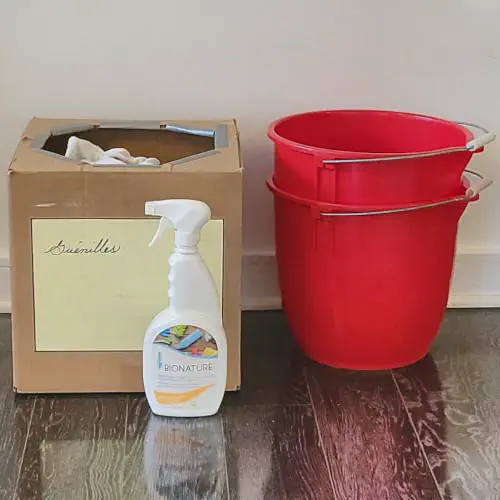 “Guénilles” means rags in french.
“Guénilles” means rags in french.During college, I was the messy one among roommates. I didn’t really pay attention to cleanliness, and even when I did, I didn’t know what I was doing. I was making many mistakes, and these are common cleaning mistakes you might also be making:
- Using the wrong kind of cleaning tools.
- Using wasteful single-use supplies, like paper towels and Swiffer mop sheets.
- Re-using dirty cloths, brushes and sponges.
- Not laundering cloths in an effective way.
- Contaminating the cleaning water by immersing dirty rags to rinse them.
- Leaving water on surfaces to air-dry.
These errors resulted in less motivation to clean, more work, and poor outcomes. My cleaning rags often smelled bad. There were visible streaks on surfaces after cleaning, I didn’t enjoy the process.
In this post, I describe the house cleaning methods I’ve researched, developed and improved over the past decade. I want to share this knowledge because proper technique and material make big differences in the effort needed and the level of cleanliness you can achieve.
My key discovery is in that you should have a stock of 50 to 100 cotton cloths as part of your basic cleaning kit. Secondly, simple but effective cleaning and laundering methods will improve the cleanliness and smell of your home with little effort. I will teach you exactly how to do it.
Table of Contents
Principles
Being aware of the following few principles will help you understand why my methods work, and will help you avoid making common cleaning mistakes that waste your energy.
Declutter before cleaning
It’s much easier to clean surfaces that are free of clutter. See A place for every thing for another detailed post on how I store my things in labelled boxes.
Psycho-physiological impact of filth
The body doesn’t like dirt and reacts poorly to the presence of pathogens.
- Seeing dirt and clutter.
- Smelling pathogens and breathing allergens.
- Putting hands and feet on dusty surfaces.
There is an energy cost to not cleaning.
Principle of least effort
To make the process worthwhile, the effort required for cleaning must be lower than the effect of the presence of dirtiness on the organism.
With the right material and methods, the net energy cost of house cleaning is less than the consequences of passively letting chaos and dirt accumulate. It feels that way at least.
Diffusion principle
Diffusion is the net movement of anything (for example, atoms, ions, molecules, energy) from a region of higher concentration to a region of lower concentration. Diffusion is driven by a gradient in concentration.
—Wikipedia
A surface cannot become cleaner than the material used to clean it. Any liquids or solid particles in a cotton cloth decreases its absorbing potential. Transfer can happen in reverse too: a cloth containing liquids and particles will transfer its content to a surface that is dryer and cleaner. To make a surface clean, it must be wiped with a perfectly clean and dry cloth.
Keeping the cleaning water clean
To avoid contaminating the cleaning water, never dip a cloth in cleaning water twice. Use a cloth once, then discard it in the laundry bucket.
Drying principle
To avoid leaving visible marks on glass, mirrors and ceramic glass, clean with a wet cloth, then wipe the surface with a dry and clean cloth. Wiping surfaces with a moist cloth is not enough. It will leave behind a film of liquid containing dissolved cleaning product and solid particles. Wiping with a dry cloth will absorb everything to finish the job.
A cloth used for drying can be dipped in water and used for cleaning, but I usually toss it in the empty bucket and use a new one if I need to clean perfectly.
Filth transportation
Cotton cloths are a medium for transporting filth and dust from the house surfaces to the washing machine’s drain. You must visualize this movement during the cleaning process. This is your main objective.
The importance of having a large stock of cloths
It’s important to have a good quantity of cloths. Between 50 and 100 is the right amount.
You must always have a reserve of clean cloths available. You will reach for clean cloths multiple times per day. For deep cleaning very dirty areas, it may take tens of clean cloths to complete the job.
Thermal energy (heat)
Use warm or hot water. Most substances will dissolve or react with cleaning products more quickly with hot water.
Material
Here is the full list of material required for house cleaning.
Base cleaning material
- Two buckets
- 50 to 100 cotton cloths
- Storage box for cloths
- General-purpose cleaner
Don’t be stingy on cloths, okay? I really think 50 to 100 cloths is a reasonable number to have.
Get thick and durable 100% cotton towel-like material. None of that microfiber nonsense. Look for “bar mops” or “kitchen towels” on Amazon and buy a couple of 30-packs.
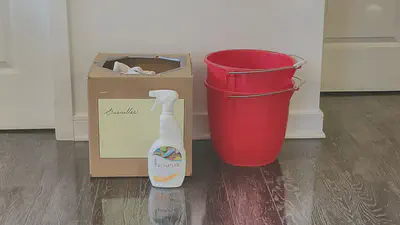
Material for dry debris pickup
A broom and a dust pan are more efficient than cotton cloths for picking up dry debris. Due to gravity, the floor is the most probable place for debris, so it makes sense to have a dedicated tool for it. Surfaces above the floor (and closer to our faces) mustn’t be cleaned with brooms but only with clean cotton cloths.
- Broom
- Dust pan
- Bin

Material for large area cleaning
- Mop
- Towels

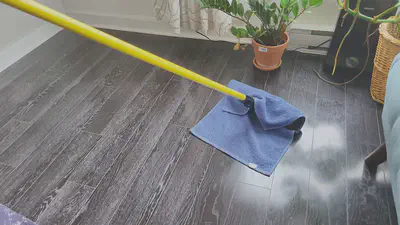
Laundry appliances and products
My point here is that wiping surfaces clean does not finish the cleaning process. The rags are just an intermediary step, a transport medium for filth. The end goal is to discard the filth through the washer’s drain. The secondary goal of laundry is to recover cleaned and decontaminated rags.
- Washer
- Dryer
- Detergent
- Bleach
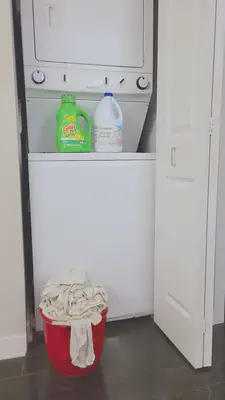
Cleaning products
I use very few cleaning products, and they are carefully chosen.
General purpose cleaner
Here are the qualities I look for in a general-purpose cleaning product.
- Harmless to humans and animals.
- Hypoallergenic.
- Smells like citrus.
- Breaks down greases.
- “Biotechnological”: it contains enzymes that break down proteins and micro-organisms.
- Ultra concentrated: I usually dilute 10-20 sprays of cleaner in 1-2 litres of water, but I can also use it at full strength.
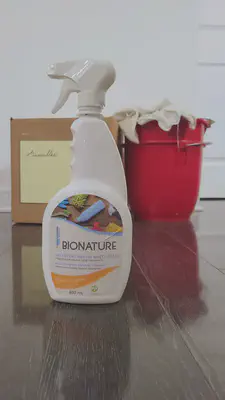
Degreaser
Similar to the general-purpose cleaner, I like an environment and human friendly product that is highly concentrated, and that I can dilute in warm water. When cleaning oil and grease, using hot water helps break down the oils.

Soft abrasive powder
Here are the qualities I look for in a soft abrasive powder.
- Harder than hardened food bits.
- Softer than metal and glass.
- Dulls quickly.
- Is removed instantly with water.
How to use: sprinkle over the dirty area or directly on a damp cloth, and scrub. Add powder as necessary, soft abrasive powder doesn’t hold its sharpness for long. It’s a feature not a bug.
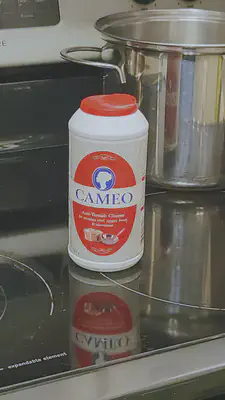
Basic cleaning method
Let’s go through the motions of the cleaning process. Prepare your cleaning material, pay attention, and remember the basic principles along the way. Visualize your objective: to lift soil from house surfaces and transport it to the washing machine’s drain.
Preparation
In a bucket, dilute general-purpose cleaner in warm water.
The other bucket is for tossing used and dirty cloths.
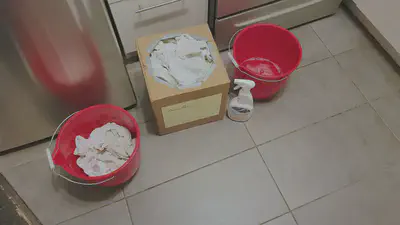
Cleaning stages
Most cleaning jobs are organized in this sequence of three stages.
Stage 1: Dry removal
Declutter the surface. Pick up sand and tiny trash with a broom or a dry rag.
The first stage is to pick up large amounts of liquid, oily or solid material using dry cloths or, for dry debris, a broom and dust pan. Skip this stage if there isn’t a lot of filth. If there is lots of filth, cleaning product is not necessary and doesn’t help. I either use just water or a dry rag. Cotton is very absorbent and will pick up mostly anything, liquid, oily or solid. After picking up sand, debris and hair with a rag, shake it over a dust bin before tossing it in the laundry bucket. Pick up what you can with dry cloths or a broom, then move on to the next stage.
Stage 2: Wet cleaning
In the second stage, we use dilution or chemical reactions to detach oils and minuscule solid debris that escape the first stage.
- Take a clean cloth.
- Dip it in warm water or diluted cleaner. The choice of cleaning agent depends on the type of cleaning job.
- Scrub and clean the surface.
- Toss the cloth in the laundry bucket.
- Repeat from step 1 as often as necessary.
Remember the principles:
- No reversing: do not contaminate the cleaning water with a used cloth.
- The diffusion principle: surfaces cannot get cleaner than the cloth used to clean them.
- You are using cloths as transportation medium for filth and dust, and you determine their one-way trajectory towards the washing machine’s drain.
Stage 3: Drying and finishing
With a dry clean cloth, dry and polish the surface.
After oils and solid debris have been detached from hard surfaces by dilution or chemical reaction, some still remain present near the surface along with a small amount of cleaning water. They must be picked up using a dry cloth. A wet cloth does not have enough absorbing potential in the final stage. We want to bring the surfaces to a dry state, and only a dry towel can make a surface dry.
Laundry for house cleaning cloths
Whenever the dirty cloths bucket is full or smelly, proceed with the laundry.
- Empty the bucket of dirty cloths in the washing machine.
- Clean the bucket with another cloth and toss the cloth in the washing machine.
- Add bleach in the bleach dispenser (optional, and use just a little).
- Add detergent.
- During washing, filth and dust leave the cloths (with the help of detergent) and exit through the drain.
- Machine dry.
- No need to fold, just stuff the cleaned cloths in their storage box.
Do not use fabric softener when laundering cleaning cloths.
Fabric softerners have these properties that are irrelevant for cleaning:
- They are chemical compounds that cover and are absorbed by the fibres.
- They “puff” the fibres, giving them a soft texture.
- They prevent static electricity.
- Add fresh fragrance.
They also have these undesirable properties:
- They contaminate the cloths.
- They reduce the cotton’s absorbant properties.
- Cloths laundered with fabric softener will leave a visible film on shiny surfaces.
Pro tips
Choosing the right moment to clean
Overall cleaning work can be greatly reduced by choosing the timing wisely.
Bathroom: after a workout. The body is flexible and warmed up, this makes it easier to reach down into corners. Plus, I like to take a shower both after a workout and after cleaning nasty stuff.
The shower: after using it. Before the soap, minerals, body oils and dead skin form into a hard crust. Existing crust is also softened by the moist and warm air, and might be easier to remove. Most times, I don’t even need cleaner, just warm water and clean cloths.
Sink: wipe right after shaving and brushing teeth.
Kitchen: right after eating. The cooktop has cooled down but the food bits didn’t harden yet.
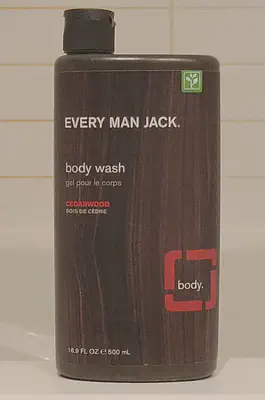
Cleaning the cleaning things
Buckets, bottles, dispensers, vaporizers, plunger, toilet brush, broom brush, appliances.
Don’t forget to clean them too!
Keep cloths at reach
Have a stock of cloths accessible from any room.
Carry one or two cloths in your bag when going out. Spills and mishaps happen outside of home too!
I always bring one or two cloths to the table when eating.
Heavy cleaning tasks
I use the exact same technique to clean very dirty surfaces, for example with mud and mildew. The only difference is that I use more cloths per surface area. I might only clean 10 cm² until a cloth is saturated. I just toss it in the empty bucket and take a new one.
Keeping the toilet bowl clean longer
When the toilet flushes, thousands of water and body fluid droplets are projected up in the bathroom air, and then fall on nearby surfaces and objects, accumulating as visible and smelly stains. This also inevitably happens when a male urinates standing up over the toilet, regardless of dexterity level and aim.
- Always close the toilet seat lid before flushing.
- As a male, urinate sitting down.
Kitchen towels
I like cleaning cloths that are very thick and absorbant. I use the same cloths for kitchen towels, which gives me an endless supply of dry towels to wipe the dishes, counters and kitchen tools.
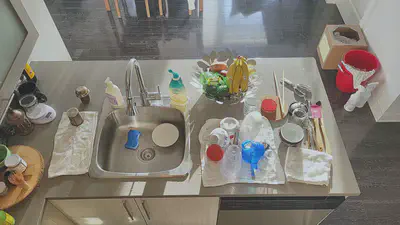
Advanced techniques
Cleaning glass-ceramic cooktops
This is my step-by-step process for getting a mirror finish on a glass-ceramic cooktop.
- Use a damp cloth to remove crumbs, and most of the fats and oils.
- Use dish soap and water to break down all the fats and oils.
- Use a soft abrasive (like Cameo) to scrub and cut through cooked crusts.
- Use water to remove the soap and the abrasive cleaner.
- Dry and polish.
Dampening cloths for dusting
For dusting, you need a damp but not wet cloth.
- Dip a cloth one third in water and remove it immediately.
- Hand squeeze it to distribute the water evenly and remove the excess.
- Use the damp cloth to wipe dusty surfaces.
- Use a dry cloth to remove all water and any residue dust.
Mirrors and glass
I don’t recommend any special method or product for cleaning mirrors and glass. The secret to avoiding streaks and smears is wiping dry with a clean dry cotton cloth after cleaning. Apply the basic cleaning method and be particularly attentive in stage 3 (drying). There is no need for an ammonia-based window cleaner or special cloth technology.
Stainless steel appliances
The most important thing to understand about stainless steel appliances surfaces is that they have a grain direction. During both the cleaning and the drying stages, you must wipe along the grain to clean inside the microscopic grooves. The direction of the grain is usually visible to the naked eye.
Conclusion and takeaways
There are two parts to an effective cleaning:
- Right material.
- 50 to 100 cotton cloths
- 2 buckets
- General-purpose cleaner
- Right method.
- Cleaning:
- Stage 1: Dry removal
- Stage 2: Wet cleaning
- Stage 3: Drying and finishing
- Laundry:
- No fabric softener on cleaning rags and towels.
- Cleaning:
If I had to pick only 3 most important principles:
- Keep the cleaning water clean. Do not dip dirty cloths back in the water to rinse them. They go straight to the laundry after one use.
- Diffusion. Only a clean dry cloth can make a surface clean and dry.
- Have enough cloths, otherwise you can’t achieve 1. and 2.
References
- Mary Moppins Cleaning System at goclean.com.